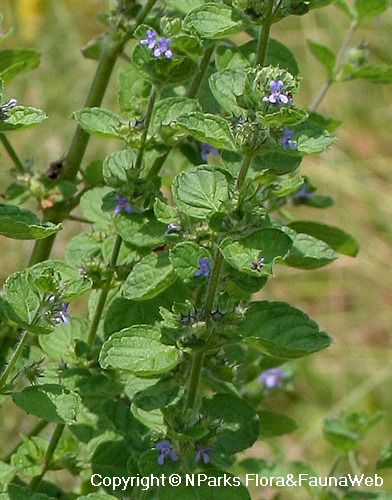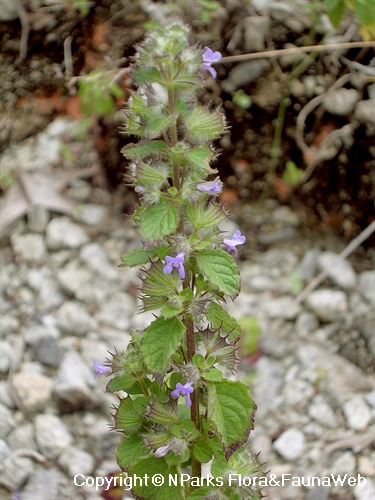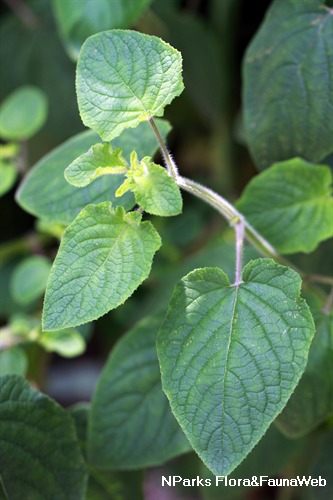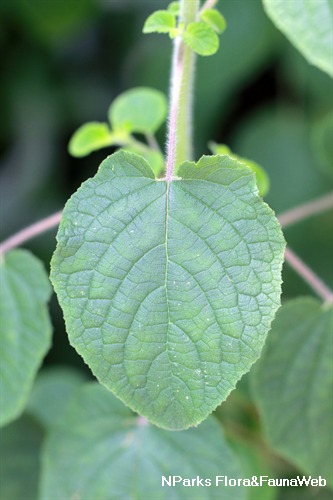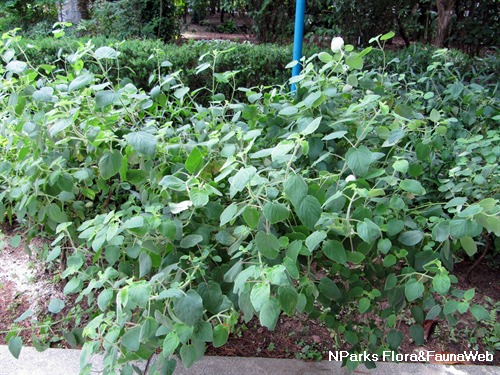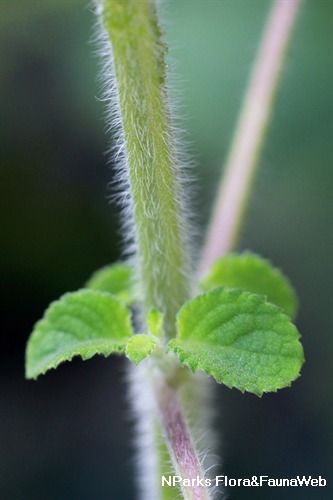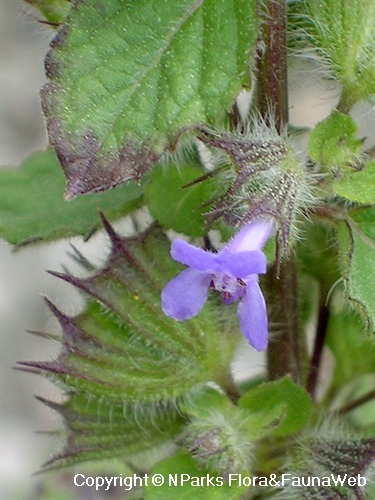
Back
Mesosphaerum suaveolens (L.) Kuntze
| Family Name: | Lamiaceae (Labiatae) |
| Synonyms: | Hyptis suaveolens (L.) Poit. |
| Common Name: | Pignut, Wild Spikenard, Horehound, 香苦草, 山香, 山薄荷, 假走马风, 狗母蘇 |
Name
Classifications and Characteristics
| Plant Division | Angiosperms (Flowering Seed Plants) (Dicotyledon) |
|---|---|
| Plant Growth Form | Herbaceous Plant |
| Lifespan (in Singapore) | Perennial |
| Mode of Nutrition | Autotrophic |
| Plant Shape | Shrubby |
| Maximum Height | 0.5 m to 1.5 m |
Biogeography
| Native Distribution | Mexico, Tropical Americas -- now widely naturalized in tropics & subtropics |
|---|---|
| Native Habitat | Terrestrial (Riverine, Grassland / Savannah/ Scrubland, Disturbed Area / Open Ground) |
| Preferred Climate Zone | Tropical |
| Local Conservation Status | Non-native (Spontaneous (Naturalised)) |
Description and Ethnobotany
| Growth Form | Strongly-aromatic, rigidly-erect and coarse-looking herbaecous shrub, up to 1.5m height. |
|---|---|
| Foliage | Leaves olive green on top, densely pubescent below, conspicuous veins and crenate margins. Emits strong minty or menthol scent, when bruised or crushed. |
| Stems | Hairy, with squarish cross-sections. |
| Flowers | Predominantly bluish-purple, tubular, 6mm across, produced from leaf axils in 2-5 flower raceme-inflorescences. Sepals ribbed, densely covered by white hairs, and edged with 5 stiff bristles each. Blooming occurs year-round. |
| Fruit | Flattened one-seeded nutlets, with v-shaped notch at one end, ripen to dark brown, becoming white and mucilaginous upon wetting. Produced from 4-lobed flower ovary. Dispersed by water, pr carried away by animals, humans. machinery and vehicles. Able to remain dormant for many years, until conditions are suitable (eg. opening of rainforest canopy). Often found as a contaminant in pasture grass seed. |
| Others - Plant Morphology | Local Conservation Status: Naturalized exotic species in Singapore, previously very common on open ground. Typically regarded as a weedy plant across the world.Control: Pull out or burn small infestations. For more extensive populations, spot-spray pre-blooming plants with amine, ester 2,4-D or other permitted herbicides. |
| Habitat | Along river banks, roadsides, open ground, bare areas and other well-drained disturbed spots. May form thick thickets at moist sites. |
| Cultivation | Prefers full sun. Tolerant of infertile and drier sites. Easily propagated by seeds or cuttings. |
| Etymology | The specific epithet suaveolens means 'fragrant' or 'sweetly scented', describing the plant's minty scent. |
| Ethnobotanical Uses | Edible Plant Parts : Edible Leaves Food (Herb or Spice) Others: Medicinal: Leaves and shoots used in anti-rheumatic and anti-fever baths, also consumed to treat spasms. Infusion of dried leaves drunk to treat fever, or drunk as ordinary beverage. Small amounts of roots chewed with betel nut as systemic treatment for wounds and skin diseases. Poulticed leaves applied to head as headache relief, or onto skin boils. Leaf juice drunk with lime juice as remedy for colic and stomachache. Leaves also ground into powder and applied as snuff to treat nosebleeds. Essential oils from leaves shown to possess anti-microbial and anti-fungal properties. In Philippines, the strong-smelling leaves are often placed under beds and chairs to drive bedbugs out. Food: Shoot tips edible and sometimes used as flavouring. Root decoction used as appetizer. Agriculture: Plant grown as green manure in parts of India, and used as cattle fodder in Indonesia. Current studies indicate that extracted leaf compounds have insecticidal properties that potentially can be developed into bio-pesticides against lepidopteran pests. |
Landscaping Features
| Desirable Plant Features | Ornamental Flowers, Fragrant (Foliage, Flowers) (Time Independent) |
|---|---|
| Landscape Uses | General, Container Planting |
| Thematic Landscaping | Economic Garden, Naturalistic Garden |
| Usage Hazard - Cons Remarks | Flower sepals edged with stiff bristles |
Fauna, Pollination and Dispersal
| Seed or Spore Dispersal | Abiotic (Water), Biotic (Fauna) |
|---|
Plant Care and Propagation
| Light Preference | Full Sun |
|---|---|
| Water Preference | Moderate Water |
| Plant Growth Rate | Moderate |
| Rootzone Tolerance | Fertile Loamy Soils, Well-Drained Soils |
| Maintenance Requirements | Moderate |
| Propagation Method | Seed, Stem Cutting |
Foliar
| Foliage Retention | Evergreen |
|---|---|
| Mature Foliage Colour(s) | Green |
| Mature Foliage Texture(s) | Velvety / Furry / Tomentose, Hairy / Hirsute, Raised / Sunken Veins, Thin |
| Foliar Type | Simple / Unifoliate |
| Foliar Arrangement Along Stem | Opposite |
| Foliar Shape(s) | Non-Palm Foliage (Ovate) |
| Foliar Venation | Pinnate / Net |
| Foliar Margin | Crenate |
| Foliar Apex - Tip | Acute |
| Foliar Base | Rounded / Obtuse, Truncate / Square |
| Typical Foliar Area | Notophyll ( 20.25cm2 - 45 cm2 ) |
| Leaf Area Index (LAI) for Green Plot Ratio | 4.5 (Shrub & Groundcover - Dicot) |
Non - Foliar and Storage
| Stem Type & Modification | Herbaceous |
|---|---|
| Root Type | Underground (Fibrous Root) |
Floral (Angiosperm)
| Flower & Plant Sexuality | Bisexual Flowers |
| Flower Colour(s) | Blue, Purple |
|---|---|
| Flower Symmetry | Bilateral |
| Inflorescence Type | Cyme |
| Flowering Period | Free-Flowering |
| Flowering Habit | Polycarpic |
Fruit, Seed and Spore
| Mature Fruit Colour(s) | Brown |
|---|---|
| Fruit Classification | Simple Fruit |
| Fruit Type | Indehiscent Dry Fruit , Nut / Nutlet |
References
| References | <1> Lindsay, S. et al. (2022). Flora of Singapore: Checklist and bibliography. Gardens’ Bulletin Singapore 74(Suppl. 1): 3–860. |
|---|
Image Repository
Others
| Master ID | 29432 |
|---|---|
| Species ID | 3741 |
| Flora Disclaimer | The information in this website has been compiled from reliable sources, such as reference works on medicinal plants. It is not a substitute for medical advice or treatment and NParks does not purport to provide any medical advice. Readers should always consult his/her physician before using or consuming a plant for medicinal purposes. |

